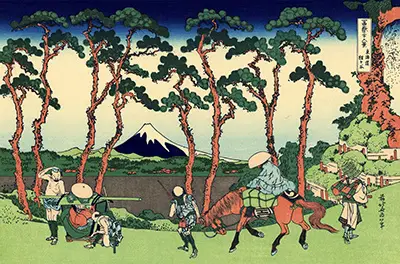A master during his own lifetime, Hokusai's paintings peaked during the last 30 years of his life with a selection of his most famous artwork included in this section.
The Great Wave of Kanagawa continues to spearhead the artist's reputation, but there is so much more to see in this extensive career. Katsushika Hokusai produced portraits and landscapes in a multitude of different mediums. For the purposes of simplicity, we have included all mediums within this section, including ink drawings, woodblock prints and the more colourful Ukiyo-e brush paintings. Hokusai would draw in techniques from Europe and Asia in order to perfect his work. His own understanding of nature, myth and history would also help to develop the content in his work. This prolific Japanese artist would produce 3,000 colour prints during his lifetime, from a career which spanned 70 years.
His keen eye and passion for the natural world ensured he was never short of inspiration for his work. During this period there was not much of an opportunity to travel around the country or abroad particularly easily. As such, Katsushika Hokusai would need to draw on his extensive collection of books to expand upon his influences and ideas for future work. The impact of Japanese artists such as Hokusai upon famous European artists is well known, but there was also some influence going in the other direction. Hokusai, for example, collected imported engravings as well as possessing endless books on worldwide art movements. Art was a significant part of Japanese culture which reminded many of the virtues of communication across cultures and languages. We can draw together the genres that he worked on and compare the similarities that can be found with the Impressionist movement, featuring the likes of Monet, Manet and Degas.
A isolationist Japan was starting to see through the work of painters like Hokusai that there was much to learn from abroad, just as much as Japan itself had a culture which others would become inspired by. This exchange would be fruitful for long periods, allowing ideas to settle and develop over time. Hokusai's prints would be collected around the world and help others to understand more about the beauty of the Japan countryside as well as the technical talents of it's finest artists. The spread of information between different cultures was far harder to achieve then than now, and so art would played a critical role in educating and inspiring in this way. Some of Europe's most famous artists, for example, would collect and copy Japanese paintings in order to better understand these alternative methods. In today's market you will find this artist regularly reproduced as large posters for those who want to add the beauty of his work to their own homes. Some of the iconic images found within the 17th to 19th century are entirely accessible to the public, even for those very new to art and seeking something with aesthetic beauty and an immediacy of impact.
Japan was a culture deep in customs and superstitions. It still continues to be so today, although somewhat diluted by the impact of western influences. Hokusai produced some erotic work in a style known as Shunga. Such a style would be considered controversial in Europe, yet in Japan was used as a powerful protection against death or fire by different sections of society. Compare that to the situation in Michelangelo's Last Judgement, where the artist was forced to cover up elements of the work due to criticism from the work's commissioners. What some would seen by some as beautiful and elegant, a celebration of the human body, would look to others as entirely unacceptable and a danger to society. Modern eras tend to be more respectful of differences, generally speaking, particularly within more developed economies.
Common Themes used by Katsushika Hokusai
Whilst being a diverse, ambitious artist who constantly attacked new ideas and techniques, Hokusai's career can be summarised into several key themes which appear repeatedly across his work. These are also seen amongst the careers of other artists from Japan at around the same time and were essentially the key attributes of a movement which achieved success at home and abroad. The nation itself had exported its style as a complete industry and greatily advanced its economy by producing reproductions of some of the iconic imagery produced by artists such as Hokusai. There was a charming and calming quality to much of their work which translated abroad without any need for explanation or back story. The simplest of forms can be understood immediately, whether one is knowledgeable of its root culture or not.
- Birds and Flowers
- Mountainous landscapes with some human activity
- Waterfalls
- Seascapes
- Portraits and family life




























































































